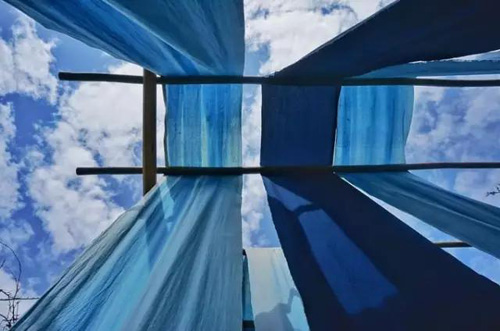记忆的味道
梅州,是客家文化的主要发源地之一,也是客家文化向外传播的核心地区,蕴藏着诸多历史文化宝藏。(Meizhou, one of the main cradles of Hakka culture as well as the core district where Hakka culture spreads outward, contains plenty of historical and cultural treasures.)
“新作蓝衫绲双襟,步步连来爱钩针;步步钩针妹刺个,着在胸前挂在心。” 这首客家山歌唱出了客家妇女的传统服装——蓝衫。在梅州,蓝衫是每个客家人的独家记忆,它承载的植物土法染布技艺不仅是客家人的非遗瑰宝,也是中华传统文化的重要组成部分之一。(In Meizhou, the Hakka blue shirt is the exclusive memory of every Hakka person. The plant dyeing technique is not only the intangible cultural heritage treasured by the people, but also one of the important components of Chinese traditional culture.)
一身客家蓝衫,承载勤勉民风

客家是唯一一个不以地域命名的民系,他们由移民相聚,分布广泛。(The Hakkas is the only national branch that isn’t named by the region. They are gathered as immigrants and have a wide distribution.)客家人主要在丘陵等贫瘠的土地上自力更生,不论男女都大量参与劳作,民风勤勉朴实,客家人的传统服饰蓝衫也随着劳动生活应运而生。(The people are diligent and live a simple lifestyle, and the Hakka blue shirt, the traditional dress of the Hakka people, was created out of their working life.)
客家传统服饰衣长及小腿,有大襟、琵琶襟、对襟等形式,以蓝、黑色为主色调,故俗称蓝衫。蓝衫由唐末及两宋时期至今已传承千年,承载着华夏特色,如其大襟的形制保留自黄帝时期汉服的交领右衽。(The blue shirt has been handed down for thousands of years from the late Tang and Song dynasties, carrying Chinese characteristics. For example, the shape of its side opening can find its origin in the cross collar right lapel of the Han clothing during the Yellow Emperor period.)
蓝衫简便朴素,以粗麻布为材,经穿耐磨,体现出客家人的节俭。(The blue shirt is made of burlap, which is simple but hard-wearing, showing the thriftiness of the Hakka people.)设计上实用方便,其挽袖几乎对折,翻折很高,内里可以装东西,又被称作“反袖口袋”。翻折后的袖子一般用别针或针线固定,不易解开,穿着时袖长较短,也利于劳作。
客家蓝衫诠释了客家人与自然和谐共生的理念。蓝染采取的是天然染模式,(The Hakka blue shirt, which is dyed naturally, embodies the concept of harmonious coexistence between the Hakka people and nature.)其原料是当地盛产的蓝草,其中适合作为染料的包括茶蓝、蓼蓝、马蓝等。
明代以前,客家人多以菘蓝为原料,采取水解法;在酒糟发酵法盛行后,蓼蓝逐渐得到广泛应用。蓝染采用还原法,将蓝草利用沉淀法萃取水溶性原靛素,制成染液的基本原料“蓝靛”;然后将蓝靛原料经由碱水、营养剂在适当温度下化成具有染着力的染液。通过控制原料配料量,可以把布染成深蓝、中蓝、浅蓝、灰、青、月白等多种颜色。(By controlling the amount of raw material used, the cloth can be dyed into various colors such as dark blue, medium blue, light blue, gray, green, and moon white.)
客家蓝衫的发展
自改革开放起,蓝染逐渐退出客家传统服饰的舞台。为了让蓝衫文化重焕生机,梅州市县各级已将客家传统服饰项目及客家传统服饰制作技艺纳入非遗项目,也有有识之士发起了复兴客家文化传统的“南山计划”,培养了一批精通客家服饰技艺的传承人们,李海燕老师就是其中一位。(In order to revive the blue shirt culture, the traditional Hakka costume project and the traditional Hakka costume-making skills have been incorporated into the intangible cultural heritage projects at municipal and county levels in Meizhou. In addition, insightful people have initiated the "Nanshan Project" to rejuvenate the Hakka cultural traditions, training a new generation who are adept at Hakka costume-making skills. Li Haiyan is one of them.)
李老师是一名80后的客家姑娘,出于对客家植物土法染布技艺的喜爱和传承初心,李老师毕业后选择了回乡发展,创建团队开设蓝染亲子体验课程、举办非遗文化进校园活动、创建自媒体账号进行线上推广、探索运用贵州蜡染技艺等,不断探索开拓传承新途径,与时下热点相结合,为蓝衫技艺传承注入新血液。(Ms. Li has established a team to offer blue-dyeing courses for families, held activities at schools to introduce the intangible cultural heritage, set up a We-Media account for online promotion, and explored the use of Guizhou batik techniques, etc. She is constantly trying to find new ways to pass down the traditional heritage and combine it with current hot topics, so as to inject new blood into the heritage of blue shirt-making skills.)
结语
孔颖达《春秋左传·正义》有言:“中国有礼仪之大,故称夏;有服章之美,谓之华。”服饰是民族传统历史中非常重要的一环。蓝衫是客家文化的具象,染布技艺则是蓝衫的制作之魂,染出了客家人的勤勉、节俭和坚韧。(Costume is an integral part of our national tradition. The blue shirt is a concrete reflection of the Hakka culture, while the dyeing craft showcases the spirit of its making, through which the people’s diligence, frugality and tenacity are also demonstrated.)
一代代传承人不懈努力,新时代青年们也肩负起保护和传承传统文化的责任,客家人的蓝衫文化又在新时代的机遇中焕发出了新的光彩。
我要评论 (网友评论仅供其表达个人看法,并不表明本站同意其观点或证实其描述)
全部评论 ( 条)